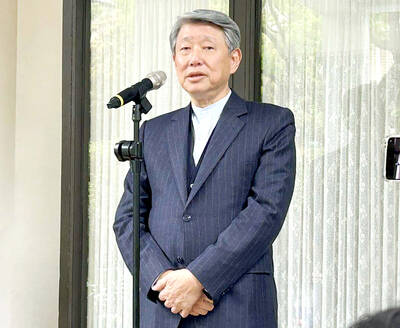Trade negotiators from the US and China resumed face-to-face talks in Washington, as the administration of US President Donald Trump said that a Chinese delegation is to visit farms next week.
Talks between a Chinese delegation led by Chinese Vice Minister of Finance Liao Min (廖岷) and US Deputy Trade Representative Jeffrey Gerrish began on Thursday and continued yesterday.
The negotiations are expected to lay the groundwork for top-level negotiations between US Trade Representative Robert Lighthizer, US Secretary of the Treasury Steven Mnuchin and Chinese Vice Premier Liu He (劉鶴) in Washington next month. An exact date for that meeting has not been released.
Stock futures edged higher in Japan, Hong Kong and Australia, while the S&P 500 Index closed little changed, within 1 percent of a record.
The burst of diplomacy follows two months of ratcheting up of the trade dispute after senior officials previously met in Shanghai in late July.
Following that meeting, Trump announced an increase in planned tariffs on an additional batch of US$300 billion of Chinese goods to 15 percent from 10 percent, which he began imposing on Sept. 1. Tariffs on some goods was delayed to Dec. 15.
Trump later announced a two-week delay on increasing existing tariffs on US$250 billion of Chinese goods to 30 percent from 25 percent, which is now set for Oct. 15.
China has targeted US exports, including agriculture products, with retaliatory tariffs, hitting farmers who are also dealing with unpredictable weather and low commodity prices.
US Department of Agriculture Secretary Sonny Perdue said on Thursday that Chinese officials would visit farms in the US next week as part of efforts to “build goodwill.”
Perdue said that he did not have any further details about the trip and that he did not know whether Beijing plans to make an announcement about additional purchases of US farm goods during the visit.
US Secretary of Commerce Wilbur Ross reiterated that the Trump administration is pressing for a deal that commits Beijing to a wide range of economic reforms.
“What we need is to correct the big imbalances, not just the current trade deficit, but also the structural imbalances, the impediments to market access, disrespect for intellectual property, forced technology transfers,” Ross said in an interview with Fox Business Network’s Maria Bartiromo. “So it’s more complicated than just buying a few more soybeans.”
Asian markets edged up yesterday as investors turn their attention to the trade talks, while keeping an eye on the Persian Gulf region after last week’s airstrikes on Saudi Arabian oil facilities fanned geopolitical tensions.
Stock markets have enjoyed a broadly positive month thanks to hopes for the talks, with both sides appearing to offer olive branches and sounding less confrontational than they did in July and last month.
A shift by central banks to easier monetary policies — or a desire to do so — is providing some much-needed support to equities, although there was some disappointment in the US Federal Reserve’s lack of forward guidance this week for further interest rate cuts.
Hong Kong was down 0.1 percent, marking a fifth straight loss, with investors on alert for further protests in the territory following clashes between pro-democracy demonstrators and police last weekend.
Shanghai ended up 0.2 percent and Tokyo closed 0.2 percent higher.

MULTIFACETED: A task force has analyzed possible scenarios and created responses to assist domestic industries in dealing with US tariffs, the economics minister said The Executive Yuan is tomorrow to announce countermeasures to US President Donald Trump’s planned reciprocal tariffs, although the details of the plan would not be made public until Monday next week, Minister of Economic Affairs J.W. Kuo (郭智輝) said yesterday. The Cabinet established an economic and trade task force in November last year to deal with US trade and tariff related issues, Kuo told reporters outside the legislature in Taipei. The task force has been analyzing and evaluating all kinds of scenarios to identify suitable responses and determine how best to assist domestic industries in managing the effects of Trump’s tariffs, he

TIGHT-LIPPED: UMC said it had no merger plans at the moment, after Nikkei Asia reported that the firm and GlobalFoundries were considering restarting merger talks United Microelectronics Corp (UMC, 聯電), the world’s No. 4 contract chipmaker, yesterday launched a new US$5 billion 12-inch chip factory in Singapore as part of its latest effort to diversify its manufacturing footprint amid growing geopolitical risks. The new factory, adjacent to UMC’s existing Singapore fab in the Pasir Res Wafer Fab Park, is scheduled to enter volume production next year, utilizing mature 22-nanometer and 28-nanometer process technologies, UMC said in a statement. The company plans to invest US$5 billion during the first phase of the new fab, which would have an installed capacity of 30,000 12-inch wafers per month, it said. The

Taiwan’s official purchasing managers’ index (PMI) last month rose 0.2 percentage points to 54.2, in a second consecutive month of expansion, thanks to front-loading demand intended to avoid potential US tariff hikes, the Chung-Hua Institution for Economic Research (CIER, 中華經濟研究院) said yesterday. While short-term demand appeared robust, uncertainties rose due to US President Donald Trump’s unpredictable trade policy, CIER president Lien Hsien-ming (連賢明) told a news conference in Taipei. Taiwan’s economy this year would be characterized by high-level fluctuations and the volatility would be wilder than most expect, Lien said Demand for electronics, particularly semiconductors, continues to benefit from US technology giants’ effort

‘SWASTICAR’: Tesla CEO Elon Musk’s close association with Donald Trump has prompted opponents to brand him a ‘Nazi’ and resulted in a dramatic drop in sales Demonstrators descended on Tesla Inc dealerships across the US, and in Europe and Canada on Saturday to protest company chief Elon Musk, who has amassed extraordinary power as a top adviser to US President Donald Trump. Waving signs with messages such as “Musk is stealing our money” and “Reclaim our country,” the protests largely took place peacefully following fiery episodes of vandalism on Tesla vehicles, dealerships and other facilities in recent weeks that US officials have denounced as terrorism. Hundreds rallied on Saturday outside the Tesla dealership in Manhattan. Some blasted Musk, the world’s richest man, while others demanded the shuttering of his